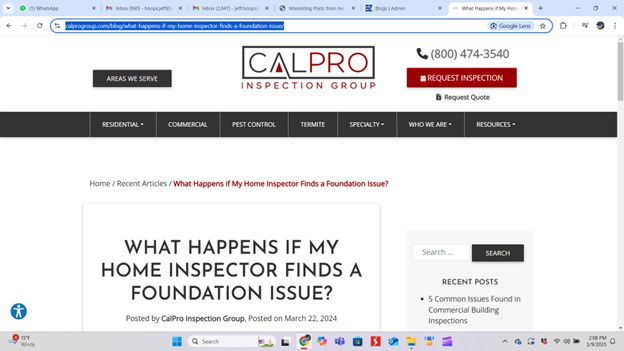Draft Results of the Inspection Might Look Like This

Draft Results of the Inspection Might Look Like This
Here are some examples of what a foundation inspection might reveal:
Cracked Foundation Walls:
Image: A close-up of a concrete foundation wall with visible cracks, some of which may be wide and deep.
Significance: Indicates potential settlement, shifting, or other structural issues.
Bowing Foundation Walls:
Image: A view of a foundation wall that is leaning or bowing outward.
Significance: Suggests significant soil pressure or erosion, potentially compromising the stability of the structure.
Uneven Floors:
Image: A level or plumb bob showing a significant slope in a floor.
Significance: A clear sign of uneven settlement, which can cause doors and windows to stick and create structural problems.
Water Damage in Basement/Crawl Space:
Image: A photo of a water-stained basement wall or floor, or visible mold growth.
Significance: Indicates potential water intrusion issues, which can weaken the foundation and lead to further damage.
Tree Roots Near Foundation:
Image: A photo showing large tree roots growing close to or into the foundation.
Significance: Tree roots can exert significant pressure on the foundation, causing it to shift or crack.
Disclaimer: These are just illustrative examples. The actual appearance of foundation problems can vary greatly depending on the specific cause and severity.
To find images:
Search online: Use search engines like Google Images with relevant keywords like "foundation cracks," "bowing foundation walls," "uneven floors," "basement water damage," and "tree roots near foundation."
Visit websites of foundation repair companies: Many companies have image galleries showcasing common foundation problems.
I hope this helps!
Please note: I am an AI chatbot and cannot provide actual images.
Disclaimer: This information is for general knowledge and informational purposes only and does not constitute professional advice.
Colorado, USA
foundation insoection report
A foundation inspection report is a crucial document that details the findings of a professional assessment of a building's foundation. While the specifics can vary, here's a general outline of what a comprehensive foundation inspection report typically includes:
Key Components of a Foundation Inspection Report:
Executive Summary:
A concise overview of the inspection's findings, highlighting any significant issues and recommended actions.
Property Information:
Address of the property.
Date and time of the inspection.
Inspector's name and credentials.
Weather conditions at the time of inspection.
General information about the building's age and construction.
Inspection Methodology:
A description of the tools and techniques used during the inspection.
Explanation of the areas inspected and any limitations to the inspection.
Observations:
Detailed descriptions of any observed foundation problems, including:
Cracks (location, size, and type).
Bowing or leaning walls.
Uneven floors or sloping.
Water damage or moisture issues.
Signs of settlement or heave.
Condition of foundation materials.
Grading and drainage issues.
Observations of the interior of the home such as sticking doors and windows, and cracks in drywall.
Photographic Documentation:
Clear photographs of any observed foundation damage.
Photos of relevant areas, such as cracks, water damage, and drainage issues.
Analysis and Interpretation:
An assessment of the severity of the observed problems.
Explanation of the potential causes of the foundation damage.
Evaluation of the impact of the foundation problems on the building's structural integrity.
Recommendations:
Specific recommendations for repairs or further evaluation.
Prioritization of recommended actions.
Estimated costs for repairs (if applicable).
Recommendations for further evaluation by structural engineers, or geotechnical engineers if needed.
Limitations:
A statement of any limitations to the inspection, such as areas that were inaccessible.
Disclaimer of liability for any undiscovered problems.
Important Considerations:
Reports should be clear, concise, and easy to understand.
Professional inspectors often use specialized software to generate detailed reports.
The report should be unbiased and objective.
By including these key components, a foundation inspection report provides homeowners with a comprehensive understanding of the condition of their foundation and the necessary steps to take.




